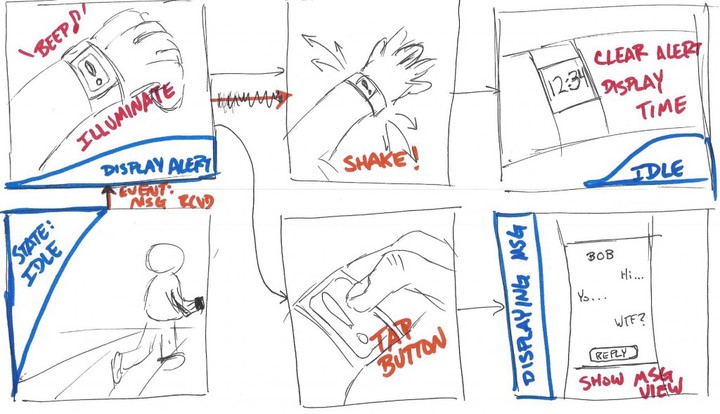Interdisciplinary design tools facilitate collaboration between engineering and design practitioners to ensure that pervasive products and services are aesthetically pleasing and technologically feasible. From our research with interdisciplinary teams, we found that a shared vocabulary and understanding of design constraints is critical for effective interdisciplinary collaboration. This requires prototyping tools to be accessible across disciplines but sufficiently powerful to develop a working system. Using our technique of electronic storyboards, design teams can electronically “sketch” how a pervasive system should behave and automatically synthesize behavioral descriptions of that system as source code, textual descriptions, and state charts. Descriptions are generated by analyzing storyboard layout, user-applied annotations, and natural language processing of text in the storyboard. During synthesis the electronic storyboard will query the design team to resolve missing or ambiguous information.
The descriptions produced by the electronic storyboard, and the tool queries during synthesis, serve as a reflection point for teams to understand if they have properly described their prototype. Storyboard synthesis is quick, taking less than one minute, and enables teams to focus on what a device “should” do, rather than how it is implemented. In a time constrained environment, rapid prototyping tools like electronic storyboards can facilitate better design outcomes by evaluating more prototypes over time. Initial results show this tool is usable by interdisciplinary teams, helps teams evaluate their design, and aids participants in understanding computational properties of the storyboarded systems.
Publications from this work:
Jason Forsyth, Tom Martin, “Extracting Behavioral Information from Electronic Storyboards”, Proceedings of the 6th ACM SIGCHI Symposium on Engineering Interactive Computer Systems, Rome, Italy, June 17-20, 2014 (18% acceptance rate) link
Jason Forsyth, Tom Martin, “Tools for Interdisciplinary Design of Pervasive Computing”,International Journal of Pervasive Computing and Communications, vol. 8, no. 2, pp. 112-132, June 2012 (Invited Survey) link
Jason Forsyth, “Using Electronic Storyboards to Support Interdisciplinary Design of Pervasive Computing Systems”, Poster Presentation for the Sixth Annual Ph.D. Forum on Pervasive Computing and Communications (PerCom), San Diego, March 20th, 2013
Ed Dorsa, Eloise Coupey, Tom Martin, Lisa McNair, Jason Forsyth, Sophie Kim, “Design Thinking Meets Computational Thinking – An Interdisciplinary Exercise in Developing Smart Product”, Industrial Design Society of America Education Symposium, August 2012 link
Funding for the work: Tom Martin (PI), Jason Forsyth, Christian James, “Storycoding I-Corps Team”, National Science Foundation. Award Date: 4/1/2015. Amount: $50,000. link
